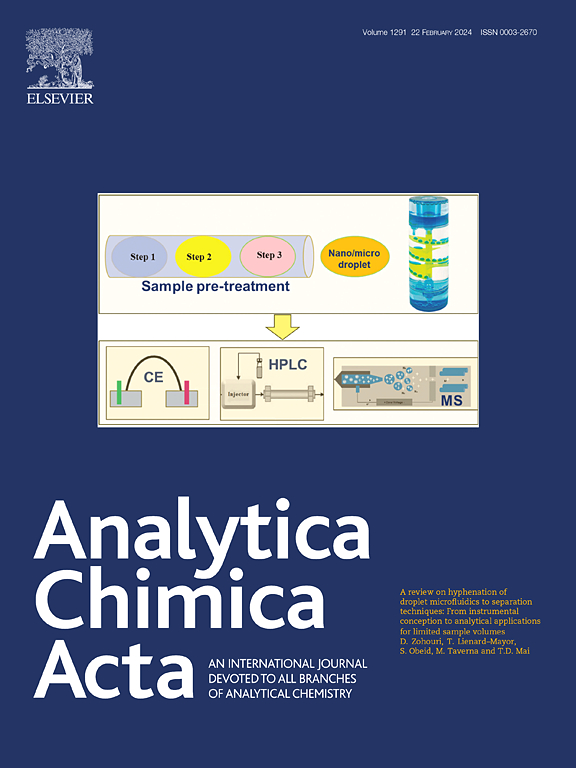用于快速、微创乳酸检测的sers微针阵列
IF 6
2区 化学
Q1 CHEMISTRY, ANALYTICAL
引用次数: 0
摘要
在剧烈运动中,无氧代谢主要在体内产生能量,导致乳酸(LA)积累,从而导致肌肉疲劳和酸痛,也可能损害神经和心血管功能。在耐力运动中,乳酸门槛(LT)是运动员清除和利用乳酸的能力的关键指标,直接影响运动成绩和耐力。因此,LA检测对于评估运动员和一般人群的身体状况以及优化训练计划至关重要。结果将金纳米壳(GNSs)、4-巯基苯硼酸(4-MPBA)和乳酸氧化酶(LOD)依次整合到MN阵列上,制备了表面增强拉曼散射(SERS)活性微针(MN)阵列,并将其插入皮肤中检测LA。然后分别用不同生理状态和运动强度的小鼠验证sers活性MN阵列的可行性。游泳3和6分钟后,洛杉矶前肢和后肢安全部队的正常小鼠增加浓度从1.94±0.33毫米和2.41±2.71±0.67毫米到0.28毫米和8.12±1.05毫米和6.43±3.79毫米和13.85±2.51毫米,分别和洛杉矶的浓度的前肢和后肢安全部队禁食老鼠增加从2.97±0.26毫米和2.84±3.62±0.23毫米到0.66毫米和7.25±1.40毫米和5.32±1.99毫米和13.07±1.05毫米,分别。这项研究首次确定了禁食动物和正常喂养动物在乳酸生成方面的差异。此外,禁食导致基线LA水平增加,尽管与正常喂养条件相比,运动期间LA积累率较低。通过进一步优化,该方法将成为运动员和一般人群运动训练和康复指导的更安全、更有效的工具。本文章由计算机程序翻译,如有差异,请以英文原文为准。


A SERS-active microneedle array for rapid and minimally invasive lactic acid detection
Background
During intense exercise, anaerobic metabolism predominantly produces energy in the body, resulting in lactic acid (LA) accumulation, which contributes to muscle fatigue and soreness and may also impair neurological and cardiovascular functions. In endurance sports, the lactate threshold (LT) is a key indicator of an athlete's capacity to clear and utilize LA, directly influencing athletic performance and endurance. Therefore, LA detection is crucial for assessing the physical condition of both athletes and the general population, as well as for optimizing training programs.
Results
A set of surface-enhanced Raman scattering (SERS)-active microneedle (MN) arrays, developed by integrating gold nanoshells (GNSs), 4-mercaptobenzeneboronic acid (4-MPBA) and lactate oxidase (LOD) onto a MN array in turn, were inserted into skins to sense LA. Then mice in different physiological states and under different exercise intensities were used to verify the feasibility of the SERS-active MN array, respectively. After swimming for 3 and 6 min, the LA concentration of forelimb and hindlimb ISF of normal mice increased from 1.94 ± 0.33 mM and 2.41 ± 0.67 mM to 2.71 ± 0.28 mM and 8.12 ± 1.05 mM, and 6.43 ± 3.79 mM and 13.85 ± 2.51 mM, respectively, and the LA concentration of forelimb and hindlimb ISF of fasting mice increased from 2.97 ± 0.26 mM and 2.84 ± 0.23 mM to 3.62 ± 0.66 mM and 7.25 ± 1.40 mM, and 5.32 ± 1.99 mM and 13.07 ± 1.05 mM, respectively.
Significance
This study is the first to identify differences in LA production between fasting and normally fed animals. Furthermore, fasting led to an increase in baseline LA levels, though the rate of LA accumulation during exercise was lower compared to normal feeding conditions. With further optimization, this method would become a safer and more effective tool for exercise training and rehabilitation guidance for both athletes and the general population.
求助全文
通过发布文献求助,成功后即可免费获取论文全文。
去求助
来源期刊

Analytica Chimica Acta
化学-分析化学
CiteScore
10.40
自引率
6.50%
发文量
1081
审稿时长
38 days
期刊介绍:
Analytica Chimica Acta has an open access mirror journal Analytica Chimica Acta: X, sharing the same aims and scope, editorial team, submission system and rigorous peer review.
Analytica Chimica Acta provides a forum for the rapid publication of original research, and critical, comprehensive reviews dealing with all aspects of fundamental and applied modern analytical chemistry. The journal welcomes the submission of research papers which report studies concerning the development of new and significant analytical methodologies. In determining the suitability of submitted articles for publication, particular scrutiny will be placed on the degree of novelty and impact of the research and the extent to which it adds to the existing body of knowledge in analytical chemistry.
 求助内容:
求助内容: 应助结果提醒方式:
应助结果提醒方式:


